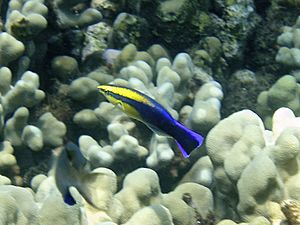Hawaiian cleaner wrasse facts for kids
Quick facts for kids Hawaiian cleaner wrasse |
|
|---|---|
 |
|
| Conservation status | |
| Scientific classification |
The Hawaiian cleaner wrasse (Labroides phthirophagus) is a small, colorful fish. It is also known as the golden cleaner wrasse. You can find this fish only around the Hawaiian Islands. It lives on coral reefs. This wrasse is a special kind of "cleaner fish." It helps other fish by eating tiny parasites off their bodies. This helpful act is called a "cleaning symbiosis."
Contents
What Does It Look Like?
The Hawaiian cleaner wrasse can grow up to about 12 centimeters (5 inches) long. It has very bright colors. The front part of its body is golden. A dark stripe runs from its eye all the way to its tail. This stripe gets wider towards the back. The back part of the fish, including its fins, has pretty purple and violet colors.
Where Does It Live?
This fish lives only around the Hawaiian Islands. You can also find it near Johnston Atoll. It prefers to live on coral reefs and rocky areas. It avoids places where waves crash strongly. You can find these fish in waters as deep as 90 meters (295 feet).
How It Lives and Behaves
The Hawaiian cleaner wrasse swims with a smooth, fluttering motion. At night, it might rest inside a special balloon-like sleeping bag. It builds this bag from its own body mucus. These fish usually stay with one partner for life. They form a pair bond during their breeding season.
This wrasse mostly eats tiny parasites that live on other fish. These parasites are called ectoparasites. The cleaner wrasse needs these parasites to survive. If it doesn't get enough, it won't be healthy.
The Hawaiian cleaner wrasse acts much like its close relative, the bluestreak cleaner wrasse. That fish lives in other parts of the Pacific Ocean. Both types of wrasse set up special spots called "cleaning stations." Larger fish, called "clients," come to these stations. The cleaner fish then removes parasites, loose skin, and mucus from them.
This arrangement helps both fish. The client fish gets rid of annoying parasites. The wrasse gets an easy meal and protection. It might seem risky for the small cleaner fish. Many client fish are piscivores, meaning they eat other fish. But in the wild, client fish rarely harm the cleaners. They seem to enjoy the gentle touch of the cleaner fish.
Cleaner fish and their clients seem to communicate. When a new client arrives, it watches the cleaner fish at work. If the cleaner's last client "jolts" (twitches suddenly), the new client might leave. This "jolting" means the cleaner might have taken a bite of the client's scales. If the new client likes what it sees, it takes a special pose. This pose tells the cleaner fish to start cleaning.
Is It Endangered?
The Hawaiian cleaner wrasse lives in a small area. But it is quite common there. Much of its home is inside the Papahānaumokuākea Marine National Monument. This is a well-managed protected area. Scientists have not found any major threats to this fish. However, damage to coral reefs could affect it. The International Union for Conservation of Nature says this fish is of "least concern." This means it is not currently in danger of disappearing.
Aquatic Trade
Sometimes, people catch this fish for aquariums around the world. You can find it for sale on many websites that sell aquatic fish.
See also
 In Spanish: Labroides phthirophagus para niños
In Spanish: Labroides phthirophagus para niños


